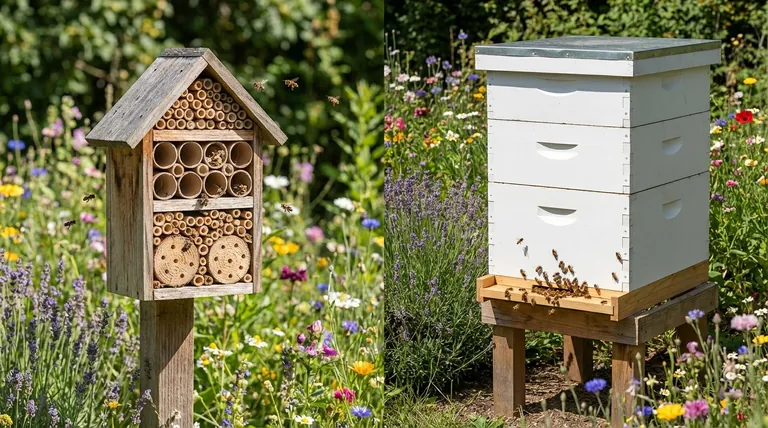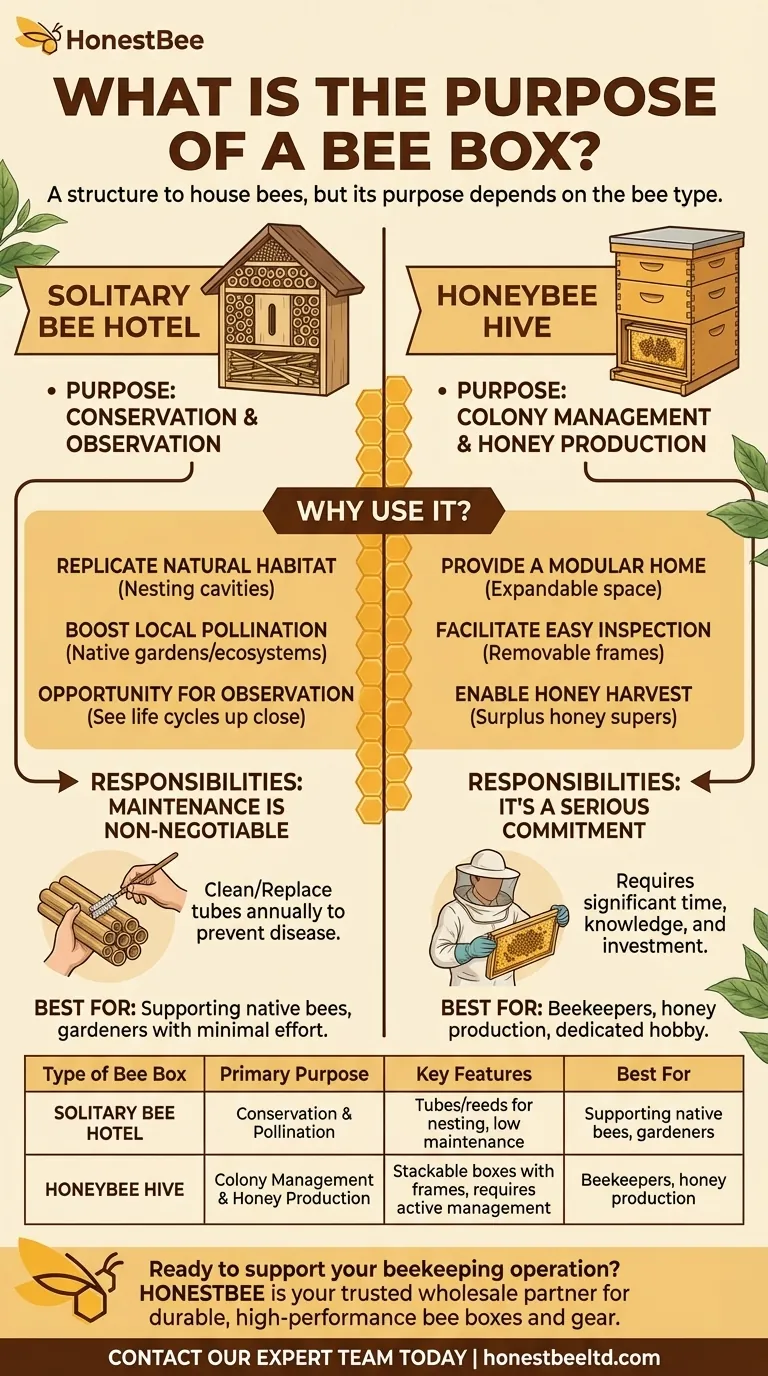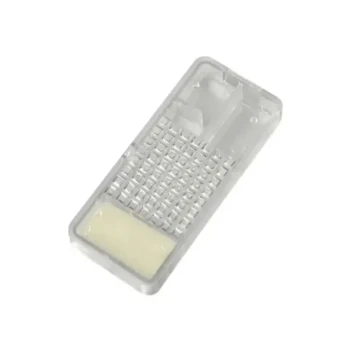At its core, a bee box is a structure designed to house bees. However, its specific purpose depends entirely on which type of bee it's for. A "bee box" can be a simple house with tubes to provide a safe nesting place for solitary native bees, or it can be a modular, managed hive for a large colony of honeybees.
The term "bee box" is often used for two fundamentally different structures: a small "bee hotel" designed to support wild, solitary pollinator populations, and a larger, multi-part "beehive" used by beekeepers to manage honeybee colonies for honey production and pollination.

Understanding the Two Types of Bee Boxes
The most critical distinction to make is between housing for solitary bees and housing for social honeybees. These two groups have vastly different life cycles and needs, and their respective "boxes" serve entirely different functions.
The "Bee Hotel" for Solitary Bees
A bee hotel is a small structure, often filled with hollow reeds, cardboard tubes, or drilled blocks of wood. It does not house a colony with a queen or produce honey.
Its purpose is conservation and observation. It provides a safe, artificial nesting site for native solitary bees like mason bees and leafcutter bees, whose natural habitats may be disappearing.
The "Beehive" for Honeybees
A modern beehive is a system of stacked boxes, often called "supers," containing frames. This is what most people picture when they think of beekeeping.
Its purpose is colony management and honey production. The modular design allows a beekeeper to inspect the colony's health, give the bees more space as they grow, and harvest excess honey.
The Deeper Purpose: Solving Different Problems
Each type of bee box solves a distinct problem, either for the bees themselves or for the people interacting with them.
Why Use a Solitary Bee Hotel?
To Replicate Natural Habitat
Solitary bees don't live in large hives. They lay their eggs in individual tunnels, such as hollow plant stems or holes left by insects in wood. A bee hotel mimics these natural nesting cavities, giving them a secure place to reproduce.
To Boost Local Pollination
Native solitary bees are incredibly effective pollinators for local gardens, orchards, and ecosystems. By providing nesting sites, you can increase their populations and support the health of your local environment.
To Offer an Opportunity for Observation
When constructed properly, these boxes offer a fascinating and safe way to see the life cycle of solitary bees up close as they build nests and seal their tunnels.
Why Use a Honeybee Hive?
To Provide a Modular Home
A honeybee colony can grow from 10,000 bees to over 60,000 in a single season. The stacked boxes of a hive allow a beekeeper to add space as the colony expands, preventing them from running out of room and swarming away.
To Facilitate Easy Inspection
The removable frames inside each box are the key to modern beekeeping. They allow the beekeeper to check on the queen, look for signs of disease, and assess the colony's food stores without destroying the bees' comb.
To Enable Honey Harvest
Beekeepers use specific boxes, often called medium or shallow "honey supers," placed on top of the hive. The bees store surplus honey here, which can be harvested without disturbing the area where they raise their young.
Understanding the Trade-offs and Responsibilities
While both types of bee boxes are beneficial, they come with very different levels of commitment and potential pitfalls.
For Bee Hotels: Maintenance is Non-Negotiable
A common mistake is to put up a solitary bee hotel and forget about it. Old tubes can harbor diseases and parasites that can harm the very bees you're trying to help. Tubes should be cleaned or replaced annually to ensure a healthy environment.
For Beehives: It's a Serious Commitment
Keeping honeybees is not a passive hobby. It requires significant knowledge, time, and financial investment to manage the colony properly, keep them healthy, and prevent swarming. It is a form of animal husbandry.
Making the Right Choice for Your Goal
The right "bee box" for you depends entirely on your objective.
- If your primary focus is to support local wildlife and improve garden pollination with minimal effort: A solitary bee hotel is the perfect choice to help native pollinators.
- If your primary focus is to produce honey, manage a complex social insect, and engage in a dedicated hobby: A full honeybee hive is the necessary equipment for beekeeping.
Ultimately, identifying your goal is the first step in providing the correct and most beneficial home for bees.
Summary Table:
| Type of Bee Box | Primary Purpose | Key Features | Best For |
|---|---|---|---|
| Solitary Bee Hotel | Conservation & Pollination | Tubes/reeds for nesting, low maintenance | Supporting native bees, gardeners |
| Honeybee Hive | Colony Management & Honey Production | Stackable boxes with frames, requires active management | Beekeepers, honey production |
Ready to support your beekeeping operation with the right supplies?
Whether you manage a large commercial apiary or distribute beekeeping equipment, HONESTBEE is your trusted wholesale partner. We supply durable, high-performance bee boxes, hive components, and essential gear to help your colonies thrive.
Contact our expert team today to discuss your wholesale needs and discover how we can help your business succeed.
Visual Guide

Related Products
- Twin Queen Styrofoam Honey Bee Nucs Mating and Breeding Box
- Professional Insulated Plastic Bee Hives
- Wholesales Dadant Size Wooden Bee Hives for Beekeeping
- Automatic Heat Preservation 6 Frame Pro Nuc Box for Honey Bee Queen Mating
- Portable Bee Mating Hive Boxes Mini Mating Nucs 8 Frames for Queen Rearing
People Also Ask
- What are the benefits of using nucs for beginning beekeepers? Ensure a Successful First Hive with a Head Start
- When can cells safely be given to nuclei? The 12-Day Rule for Successful Queen Introduction
- What are the best times to pick up a nucleus colony? Ensure a Strong Start for Your Apiary
- What is the process for installing a nucleus hive into a new hive? A Step-by-Step Guide for Beekeepers
- What are the three key points to understand when making a nucleus? Master Bee Behavior for Success



















